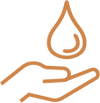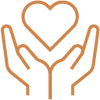Materials Life Cycle Assessment (LCA) is a method used to evaluate the environmental impact of materials throughout their entire life cycle, from extraction or creation to disposal.
It considers factors such as resource use, energy consumption, emissions, and waste generation. LCA helps us understand the ecological footprint of the fabrics we carry in the shop. This knowledge empowers us (and you) to make informed choices when selecting new fabrics. It guides us in curating a collection that leaves a gentle footprint on the environment, ensuring our shared commitment to sustainability.
At each stage of its lifecycle, a fabric earns "one leaf" whenever it meets our sustainability standards. If it's really nailing it, it could get five leaves – our superstar 5-leaf wonder! But even achieving four leaves is pretty awesome, as it leaves space for us to keep getting better. Now, let's dive into the nitty-gritty of how we give out those leaves.
Resources
Sustainable fabric production begins at the resource stage, where the raw materials are cultivated or sourced while considering ecological balance, resource efficiency, and social responsibility.
In our leaf-rating assessment, a fabric garners its initial "one leaf" for resources when it showcases its origin through responsible cultivation/sourcing methods. This leaf symbolizes the start to a journey that leaves a positive impact every step of the way.
Examples of sustainable fibers that may earn a leaf:

Organic Cotton
Grown without synthetic pesticides or GMOs, it promotes healthy soil and reduces chemical exposure for workers and ecosystems. Is grown with rain water instead of irrigation, so uses significantly less water.

Hemp
Is known for its rapid growth without the need for much water or pesticides.

Flax
Used to make linen, requires less water and fewer chemicals than other crops like cotton. Does not require chemical pesticides or fertilizers.

Recycled Fibres
Repurposing discarded fabrics, ocean plastic, and water bottles to produce new textiles like recycled polyester or cotton. Reduces the need for virgin resources.

Tencel
Comes from relatively fast-growing eucalyptus trees in sustainably managed forests that require no pesticide or herbicide use. The chemical solvent used to break down the wood into pulp is non-toxic, and more than 99% of it can also be recovered and reused, making this an incredibly sustainable closed loop process with almost no waste.
Sustainable fabric cultivation or sourcing involves:

Organic Farming
Omits synthetic pesticides and GMOs, fostering healthier soil and reducing pollution.

Regenerative Agriculture
Restores soil, biodiversity, and carbon levels for ecosystem resilience.

Sustainably Managed Forests
Ensures a renewable supply of materials while protecting biodiversity and mitigating the environmental impact of resource extraction.

Water Management
Cuts consumption through responsible irrigation and water-saving techniques.

Ethical Labor
Ensures social sustainability via fair wages, safe conditions, and worker rights.

Certifications
At the resource stage, GOTS (Global Organic Textile Standard) certification ensures traceability and that the organic fibers are grown and sourced according to strict environmental criteria (no synthetic pesticides, genetically modified organisms, and synthetic fertilizers) and social criteria (fair waige and labor practices). FSC (Forest Stewardship Council) certification ensures wood-based fibres are sourced from responsibly managed forests, protecting biodiversity, preventing deforestation, and respecting the rights of indigenous and local communities.
Manufacturing
Sustainable manufacturing practices are approaches and techniques used in the textile industry to minimize negative environmental and social impacts associated with fabric production. These practices aim to reduce pollution and waste while ensuring ethical working conditions and social responsibility.
When it comes to our fabric suppliers, transparency and traceability are the cornerstones of our partnerships. We firmly believe that transparency about the entire production process builds a foundation of trust and fosters responsible choices.
Each fabric that meets our sustainable manufacturing criteria earns itself "one leaf" for manufacturing.
Sustainable manufacturing practices that may earn a leaf:

Resource & Energy Efficiency
Resource-efficient processes, such as waterless dyeing techniques or water recycling reduce water usage and pollution, while energy-efficient machinery, renewable energy sources (like solar or wind power), and optimized production processes reduce greenhouse gas emissions and energy consumption.

Low-Impact Dyeing
Low-Impact and natural dyes reduce water, chemical use, and wastewater pollution.

Reducing Chemical Usage
Substituting chemicals and dyes with safer alternatives reduces pollution and environmental damage.

Closed-Loop Systems
Capturing and reusing water and chemicals in the production cycle helps to minimize water and chemical waste.

Recycling and Upcycling
Reducing the demand for virgin materials helps reduce steps in the manufacturing process and keeps materials out of landfills.

Ethical Labor Practices
Ensuring fair wages, safe working conditions, and workers' rights throughout the supply chain indicates social sustainability.

Certifications
At the manufacturing stage, certifications like Global Organic Textile Standard (GOTS), OEKO-TEX Standard 100 and STeP ensure that fabrics are produced using environmentally friendly processes regarding chemical use, water, energy and waste management, and socially responsible practices including fair and safe working conditions. Learn more about certifications on our blog.
Transportation
Transportation plays a significant role in the environmental impact of fabric production. From raw materials to manufacturing to distribution, fabrics often cross borders and continents during production, leading to greenhouse gas emissions and other environmental concerns. International shipping, especially by air, has a higher carbon footprint than land or sea transportation.
At Core Fabrics, to earn that coveted "one leaf" for transportation, a fabric will generally be produced in North America so the transportation burden is reduced in order to reach us (and trust us, it ain't easy to find!)
Sustainable transportation practices that may earn a leaf:

Local Sourcing
Reduces transportation distances and associated emissions.

Transportation Modes
Sea and rail transport generally have lower emissions than air transport.

Consolidation and Efficiency
Consolidating shipments and optimizing transport routes can reduce the number of trips and lower emissions.

Carbon Offsetting
Some companies (including Core Fabrics!) use carbon offsetting initiatives to mitigate their transportation emissions. This involves investing in projects that reduce or capture an equivalent amount of carbon emissions elsewhere.
Usage
Determining a fabric's degree of sustainability in its usage involves several factors contributing to its longevity, versatility, and overall environmental impact throughout its lifecycle.
Usage criteria that may earn a leaf:

Material Selection
Fabrics made from natural fibres like organic cotton, linen, Tencel, and recycled materials have a lower environmental impact than synthetic fabrics, which shed microplastic fibres when worn and laundered. Microplastics are too small to be effectively captured by wastewater treatment plants, leading to their release into rivers, oceans, and other aquatic environments.

Durability
Sustainable fabrics are built to last. They resist wear and tear, fading and pilling, ensuring your make remains in good condition over multiple uses and washes.

Versatility
Fabrics that can be worn in various settings and are adaptable to different weather conditions can reduce the need for a large wardrobe and promote a more sustainable approach to fashion.

Low Maintenance
Fabrics that require minimal care, such as lower washing temperatures, less frequent washing, and avoiding dry cleaning, help conserve water and energy.
End-Of-Life
Sustainable end-of-life practices for fabrics contribute to reducing landfill waste, conserving resources, and minimizing the environmental impact of the textile industry.
At Core Fabrics, we give "one leaf" for end-of-life to recyclable and biodegradable fabrics. These fabrics offer an eco-friendly alternative to synthetic materials that may persist in the environment for extended periods. This applies only to fabrics that do not have finishing treatments added in the manufacturing process that prevent biodegrading or release harmful chemicals into the soil as the fabric breaks down.
End-of-life factors that may earn a leaf:

Cotton
Made from cotton plant fibres, it naturally decomposes over time.

Linen
Derived from flax, it's durable and decomposes quickly, especially when exposed to moisture.

Hemp
The hemp plant's fibres are naturally biodegradable, known for strength and sustainability.

Tencel (Lyocell)
Sourced from wood pulp, it's biodegradable and breaks down in the soil. The chemicals used to make the fabric are non-toxic, so no toxic chemicals are released into the soil during this process.

Wool
Obtained from sheep, this natural protein fibre decomposes in the soil, releasing nutrients.

Silk
Produced by silkworms, it's a natural protein fibre that contributes to soil enrichment.
